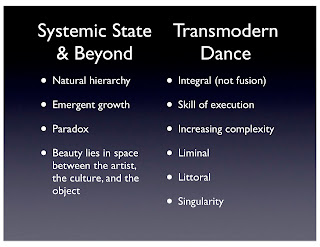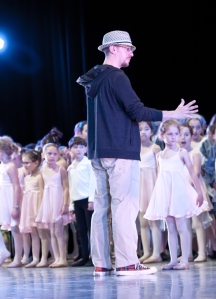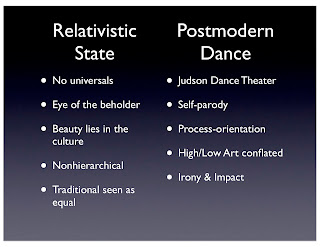Dance Paradigms (Part 8: Transmodern Dance)
Graves suggests the next level beyond Relativistic postmodernism is the Systemic state. The Systemic state builds off of the strengths and weaknesses of the Relativistic state.
The pluralistic relativism that postmodernism brought to our society insisted on seeing all states as equal in order to upend oppressive hierarchies. In seeing traditional dance as equal to classical as equal to modern as equal to postmodern, relativistic thinking ignored the natural increase in complexity and growth. Systemic thinking, in contrast, embraces this pattern of development as a natural, not oppressive, hierarchy.
Systemic thinking believes that universals do once again exist, but that most of what we understand is contextual and we could never know for sure that the universals we personally believe in are indeed universal. Therefore, Systemic thinking is comfortable with paradox.
Beauty does not lie in the object alone, or in the artist alone, or in the viewer alone. Beauty lies in the space of experience between the artist, the object, and the culture and, therefore, is co-determined. Social theorists suggest that we are transitioning from the postmodern era into the transmodern era.
Some contemporary artists are already grappling with these ‘transmodern’ concepts. Based on Graves’ systemic state, what might a transmodern dance movement look like?
I personally believe it is already emerging. We see it in the integrating of postmodern, modern, classical, and traditional concepts. However, it is vital, if the next era does indeed build on the strengths and weakness of the one preceding it, that we recognize the difference in complexity and development.
Without recognizing this complexity, we end up with artistically vapid fusions. For example, the contemporary artist who willy-nilly intersperses his modern dance technique with tribal dance steps creates an entertaining fusion of tribal-modern.
On the contrary, the contemporary artist who, through inquiry and collaboration, integrates concepts from tribal dance (such as ritual, community, symbiotic relationships between music and movement) with modern technical developments, and postmodern theatrical devices and processes goes beyond a sophomoric blend of styles and begins to develop a truly transmodern artistic statement.
This artist has incorporated aspects of all the preceding movements into his work. Like the postmodernists, he has embraced all states, but he does so with awareness of the increasing level of complexity. In integrating classicism and modernism into his work, skill of execution once again becomes important, but it is not placed above the process-driven postmodern developments.
The term ‘transmodern’ was first coined in 1989 by Spanish philosopher Rosa Maria Rodriguez Magda and has been described artistically by Professor James Mahoney of the University of Maryland, Baltimore County as exhibiting three qualities: the liminal, the littoral, and the singularity. By liminal, Mahoney means the artwork displays a sense of being in a threshold state of transformation—neither clearly here nor there, this nor that. Drawing from the postmodern emphasis on process over product, transmodern liminality goes further in embracing ambiguity, paradox, and uncertainty within the fabric of the work.
In graduate school I got to see the work of my classmate and NYC dance-artist Keely Garfield who worked intimately with this idea of liminality. Was her work a ritual or performance? Is the ‘audience’ participant or observer? Was this a finished product or a stage in an ongoing process? When will this dance start or has it been going on for sometime already?
By littoral, he means that contemporary ‘transmodern’ work incorporates anything that washes up on the shore of our culture. Anything—objects, images, soundbites, emotions—from our current culture infiltrates, even becomes the material, for the work.
I took my son to the Aldrich Contemporary Art Museum looking for any evidence of the littoral and we found it extensively used in all but one of the exhibits. In particular, one installation was a soundscape created by lining the walls of the room with plastic grocery bags hooked up to motors that were connected to a computer. As we stood in the middle, the bags whirred around us in intricate rhythmic and musical patterns. The artist (I apologize for not remembering the name) had quite literally made a work of art out of litter.
By singularity, Mahoney refers to Ray Kurzweil’s book The Singularity is Near which in fantastic and apocalyptic terms, explores the future merging of the technological and the biological. Artistically, this is seen in the increasing rate at which artists are exploring new developments in technology in their work.
Originally I was hesitant about technology and multimedia in dance. While still in my modernist mindset, I felt that the technology took away from the organic aspects of live dance. Now, I see technology as an organic extension of what it means to be human and am beginning to explore ways in which live performance and technology merge.
One of the dangers in a transmodern perspective to dance is, as the postmodernist would fear, that it would be used to label and categorize, creating once again an oppressive intellectual hierarchy. In addition, the transmodern perspective and its embrace of skill of execution could be misused to regress to modernist viewpoints; confusing re-modernism with expansive transmodernism.
A healthy transmodern movement would not discard any of the developments of postmodernism, modernism, classicism, or traditionalism. Instead, it would embrace them all and continue to expand toward greater complexity.
Graves sees his conceptual framework as an open ended one. It does not have a final state at which to arrive. There are an infinite number of potential states. When a person finds himself or herself at a certain state, it is because it is evolutionarily appropriate for his or her current conditions. This dismisses the individual from being able to claim superiority over another based on their developmental state.



Comments
Post a Comment